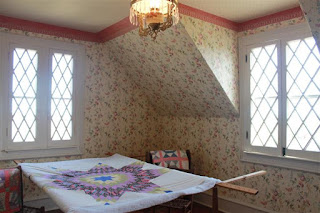"Lone Star Historian 2" is a blog about the travels and activities of the State Historian of Texas during his second year. Bill O'Neal was appointed to a two-year term by Gov. Rick Perry on August 22, 2012, at an impressive ceremony in the State Capitol. Bill is headquartered at Panola College (www.panola.edu) in Carthage, where he has taught since 1970. For more than 20 years Bill conducted the state's first Traveling Texas History class, a three-hour credit course which featured a 2,100-mile itinerary. In 2000 he was awarded a Piper Professorship, and in 2012 he received the Lifetime Achievement Award from the Wild West Historical Association. Bill has published over 40 books, almost half about Texas history subjects, and in 2007 he was named Best Living Non-Fiction Writer by True West Magazine. In 2013 he was awarded an honorary Doctor of Letters degree by his alma mater, Texas A&M University - Commerce.
 |
At the Quanah Parker Trail Arrow in
front of the house where the chief visited. |
Twice per summer for two decades, beginning in 1976, I
conducted a Traveling Texas History Course from Panola College in Carthage. The
class carried three hours’ credit, and was built around a seven-day, 2,100-mile
itinerary to historic sites across the Lone Star State. On the second morning,
as we drove northwest on Highway 287 toward Amarillo and Palo Duro Canyon, our
Panola vans passed through the hamlet of Goodnight. As the Fort Worth and
Denver City Railroad built through the area in 1887, a watering stop was named in
honor of legendary cattleman Charles Goodnight.
Goodnight opened five cattle trails, the most famous of which
was the Goodnight-Loving Trail. He had an uncanny sense of direction and
terrain, and his masterful organization and careful precautions earned him safe
passage where others encountered various disasters. His most famous ranch was
the JAs, named after British financier John Adair. At its height, in the
mid-1880s, more than 100,000 JA cattle grazed on over 1,335,000 acres. The headquarters
complex of the JAs was in Palo Duro Canyon. Early in our marriage in 1994,
Karon and I visited these historic buildings, while researching Historic Ranches of the Old West, which
was published by Eakin Press in 1997. The old JAs headquarters structures still
are in use and are little changed from the 1800s.

Adair died in 1885, and within two years Goodnight and Adair’s
widow made a settlement that involved the sale of his minority interest. In
1887 the Fort Worth and Denver City Railroad laid tracks through Armstrong
County and named a townsite after the famed cattleman. Goodnight and his wife
Molly moved to the prospective community and in the area he established a new ranch.
Goodnight and his wife Molly built a two-story, rambling frame house where the
famed cattleman spent the last four decades of his life.
The Goodnight house was the first Panhandle home designed by
an architect. The floor plan and many distinctive architectural features were
Victorian in style. The home featured a large second-floor sleeping porch in
the rear, as well as an office behind the ground-floor master bedroom. The
office was decorated to his tastes, and when Karon and I toured the house, our
docent accurately described it as his “man cave.” Quanah Parker was among the
frontier notables who visited with Goodnight in the den. Rancher-author J.
Evetts Haley also spent time with Goodnight, later producing a classic
biography of the pioneer rancher.
 |
| Rear of the house sleeping porch on the 2nd level |
Goodnight sold the ranch
in 1919, with the provision that he and Molly could live out their lives in the
house they had built. Molly died in 1926, after 55 years of marriage, and
Goodnight passed away three years later, at the age of 93. Goodnight was buried
beside Molly at the Goodnight Cemetery, on a hilltop west of the little
community.
 |
"Back from the Brink," statue showing Molly Goodnight
nurturing a buffalo calf on the home ranch. |
Cleo Hubbard, raised by Goodnight, was the longtime foreman
of the Goodnight Ranch. His daughter, Montie, was born in the house. Montie
taught for three decades in the schools of nearby Claude, and she and her
husband Emery Goodin, make their home in a ranch house a short distance south
of the old Goodnight house. Montie Goodin has been a force in historical preservation
of the region, and beginning in 2005 she led a multi-million dollar restoration
of the Goodnight home. The original paint and wallpaper were discovered and
duplicated, and the house boasts numerous furnishings and decorative items from
the Goodnight couple.
 |
| School for ranch children |
 |
| J. Evetts Haley Visitor and Events Center |
The house opened to the public in 2013, and the J. Evetts
Haley Visitor and Event Center was erected in front of the historic home and
outbuildings. There are excellent artifacts and exhibits in the Haley Visitor
Center, and the house, of course, is the most tangible reminder of Goodnight’s
past. Goodnight was an iconic figure of the cattle frontier, and in 1956 he was
one of five charter members of the National Cowboy Hall of Fame. The Charles
Goodnight Historical Center, located on Highway 287 about 40 miles east of Amarillo,
is a Texas history treat that should not be missed.
 |
| Working a rolling exhibit |
For more information:
http://www.armstrongcountymuseum.com/visitor-center.html
 |
| Sleeping porch |
 |
| Goodnight's "man cave" |
 |
| Dining room with restored wallpaper |

 Adair died in 1885, and within two years Goodnight and Adair’s
widow made a settlement that involved the sale of his minority interest. In
1887 the Fort Worth and Denver City Railroad laid tracks through Armstrong
County and named a townsite after the famed cattleman. Goodnight and his wife
Molly moved to the prospective community and in the area he established a new ranch.
Goodnight and his wife Molly built a two-story, rambling frame house where the
famed cattleman spent the last four decades of his life.
Adair died in 1885, and within two years Goodnight and Adair’s
widow made a settlement that involved the sale of his minority interest. In
1887 the Fort Worth and Denver City Railroad laid tracks through Armstrong
County and named a townsite after the famed cattleman. Goodnight and his wife
Molly moved to the prospective community and in the area he established a new ranch.
Goodnight and his wife Molly built a two-story, rambling frame house where the
famed cattleman spent the last four decades of his life.
















No comments:
Post a Comment